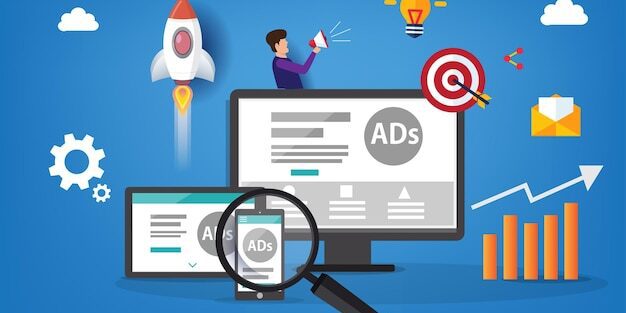If you’re new to digital advertising, Google Ads is a great place to start. With over 246 million unique visitors per month, Google is the most popular search engine in the world.
By using Google Ads, you can place ads in front of potential customers who are actively searching for products or services like yours.
In this article, we’ll cover the Google Ads Basics, including ad types, targeting options, and campaign structure.
What is Google Ads?
Google Ads is an online advertising platform created by Google. It allows businesses to display their ads on Google’s search results page and other properties, such as YouTube and Google Maps. You can hire a google ads agency for expert google ads campaign handling
By using Google Ads, businesses can reach potential customers who are actively searching for products or services like theirs.
The platform works on a pay-per-click (PPC) model, which means that businesses only pay when someone clicks on their ad. Google Ads offers a variety of ad formats, including search ads, display ads, video ads, shopping ads, and app ads.
It also provides various targeting options, such as keyword targeting, location targeting, demographic targeting, and device targeting, to help businesses reach their desired audience.
Different Types of Google Ads
Google Ads offers several types of ads that businesses can use to reach their target audience. Each ad type has its own unique features and benefits. Here are the most common ad types in Google Ads:
1. Search Ads:
These are text ads that appear at the top or bottom of Google’s search results page when someone searches for specific keywords. Search ads are great for targeting potential customers who are actively searching for products or services like yours.
2. Display Ads:
These are visual ads that appear on websites that are part of the Google Display Network. The Display Network includes millions of websites, videos, and apps, so businesses can reach a wide range of potential customers with these ads.
3. Video Ads:
These are ads that appear before, during, or after YouTube videos or on other video partner sites in the Google Display Network. Video ads can be a great way to engage potential customers and showcase your products or services.
4. Shopping Ads:
These are ads that appear at the top of Google’s search results page when someone searches for a specific product. Shopping ads include an image of the product, its price, and a link to the retailer’s website.
5. App Ads:
These are ads that appear within mobile apps that are part of the Google AdMob network. App ads can be used to promote your app, drive app installs, or encourage users to take a specific action within your app.
Each ad type in Google Ads has its own set of best practices and targeting options. By understanding the different ad types and how to use them effectively, businesses can create successful campaigns that drive results.
The Different Targeting Options in Google Ads
1. Keywords Targeting
Keyword targeting is the most common targeting option in Google Ads. With this option, you can choose specific keywords related to your products or services and show your ads to people who are searching for those keywords. Keyword targeting can be used for both search and display ads.
With keyword targeting, you can:
- Reach people who are actively searching for products or services like yours.
- Use negative keywords to prevent your ads from showing to people who are searching for irrelevant or unrelated keywords.
- Adjust your bids based on the performance of specific keywords.
2. Location Targeting
Location targeting allows you to show your ads to people in specific geographic locations. You can target people by country, state, city, or even zip code. With location targeting, you can:
- Reach people who are most likely to be interested in your products or services based on their location.
- Exclude locations where your products or services are not available.
- Adjust your bids based on the performance of specific locations.
3. Demographic Targeting
Demographic targeting allows you to show your ads to people based on their age, gender, parental status, and household income.
With demographic targeting, you can:
- Reach people who are most likely to be interested in your products or services based on their demographics.
- Use bid adjustments to reach specific demographics more effectively.
- Exclude certain demographics that are not relevant to your products or services.
4. Audience Targeting
Audience targeting allows you to show your ads to people who have previously interacted with your website, app, or YouTube channel, or who share similar characteristics to those people.
With audience targeting, you can:
- Reach people who are already familiar with your brand and are more likely to convert.
- Use different audience types, such as remarketing lists, in-market audiences, and custom audiences, to reach specific groups of people more effectively.
- Exclude certain audience types that are not relevant to your products or services.
Campaign Structure of Google Ads
When it comes to creating successful Google Ads campaigns, having a solid campaign structure is crucial. A well-structured campaign can make it easier to manage your ads, track their performance, and optimize your targeting and bidding.
Campaign Levels
At the top level, a Google Ads account can have multiple campaigns. Each campaign can have its own budget, bidding strategy, targeting options, and ad groups. Within each campaign, you can create multiple ad groups to organize your ads based on specific themes or products. The platform uses a hierarchical structure to organize ad campaigns.
Components of a Google Ads Campaign
There are several components that make up a Google Ads campaign. These include:
1. Campaign settings:
These are the settings that you configure at the campaign level, including the campaign name, budget, bidding strategy, ad schedule, location targeting, language targeting, and more.
2. Ad groups:
Ad groups are groups of ads that are organized around a specific theme or product. Within each ad group, you can create multiple ads and target specific keywords.
3. Keywords:
Keywords are the words or phrases that trigger your ads to show in search results. You can add multiple keywords to each ad group and use match types to control how closely the keyword needs to match the search query to trigger your ad.
4. Ads:
Ads are the messages that you create to reach your target audience. You can create different types of ads, including text ads, image ads, video ads, and more. Each ad can have its own headlines, descriptions, and URLs.
5. Bids:
Bids are the maximum amount that you are willing to pay for a click on your ad. You can set bids at the keyword level, ad group level, or campaign level.
Best Practices for Campaign Structure:
To create a successful Google Ads campaign, it’s important to follow some best practices for campaign structure. These include:
- Keep your campaigns focused: Create separate campaigns for different products, services, or marketing goals to make it easier to manage and optimize your ads.
- Use ad groups to organize your ads: Create ad groups around specific themes or products and target specific keywords to increase the relevance of your ads.
- Choose the right match types: Use match types to control how closely the keyword needs to match the search query to trigger your ad.
- Create relevant ads: Create ads that are relevant to the keywords you are targeting and include a clear call to action to encourage clicks and conversions.
- Monitor and optimize your campaigns: Monitor the performance of your campaigns and make adjustments to your targeting, bidding, and ad copy as needed to improve the performance of your ads.
Conclusion:
Google Ads is a powerful tool for reaching potential customers and growing your business. By understanding the basics of ad types, targeting options, and campaign structure, you can create effective and efficient campaigns that drive results. Remember to keep an eye on your performance metrics and make adjustments as needed to ensure your ads are reaching the right people at the right time. Happy advertising!
FAQs:
A: The cost of Google Ads varies depending on several factors, including your industry, keywords, and competition. You set your own budget and bidding strategy, so you have control over how much you spend.
A: You can use Google’s Keyword Planner tool to research and choose keywords for your campaign. You’ll want to choose keywords that are relevant to your business and have high search volume but low competition.
A: Yes, Google Ads is a great way to advertise local businesses. You can use location targeting to show your ads to people in your local area, and you can also include location-specific information in your ad copy.



